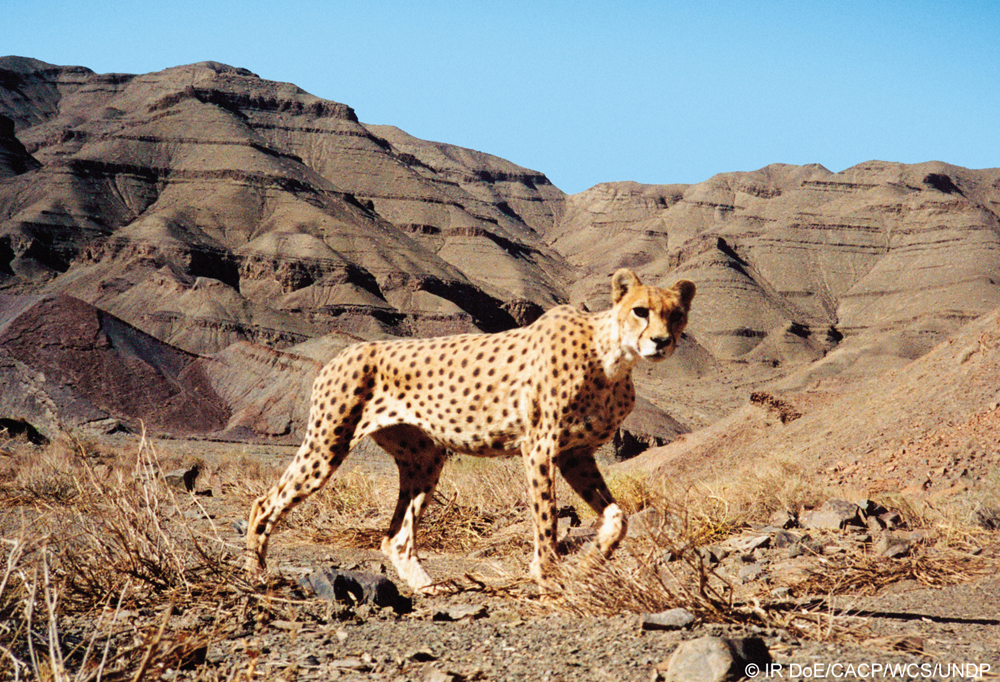 Several weeks ago, National Geographic magazine published extraordinary new images of wild Asiatic cheetahs in Iran. Shown cresting a barren, mountainous ridge devoid of green, Iran's cheetahs could not be any more distant -- geographically and ecologically -- from their African counterparts pictured in the same article navigating tourist traffic-jams on Kenyan grasslands. And unlike Kenya's spectacularly photogenic cheetahs, Iranian cats are virtually invisible. Intensely shy, scattered like grains of sand over Iran's vast central plateau, and hovering on the edge of extinction, they are essentially impossible to see.
Several weeks ago, National Geographic magazine published extraordinary new images of wild Asiatic cheetahs in Iran. Shown cresting a barren, mountainous ridge devoid of green, Iran's cheetahs could not be any more distant -- geographically and ecologically -- from their African counterparts pictured in the same article navigating tourist traffic-jams on Kenyan grasslands. And unlike Kenya's spectacularly photogenic cheetahs, Iranian cats are virtually invisible. Intensely shy, scattered like grains of sand over Iran's vast central plateau, and hovering on the edge of extinction, they are essentially impossible to see.
That National Geographic was able to photograph these rarest of cheetahs is testament to eleven years of conservation work by the Iranian Department of Environment. In 2001, with support from the United Nations Development Programme, the DoE initiated a comprehensive long-term program to pull the cheetah back from the extinction cliff. The ambitious "Conservation of the Asiatic Cheetah Project" (CACP) designated five landscapes as specially protected cheetah reserves and provided the resources to make them safe havens- dozens of dedicated cheetah guards, new vehicles, motorbikes and other materiel. Alongside the necessity of vigorous protection, the CACP mounted a nationwide campaign to draw attention to the cheetah's plight. Back then, most Iranians had no idea they were the custodians of the last Asiatic cheetahs on earth. By the time of my first visit to Iran in 2004, that had already changed. When buying supplies in a roadside store in a tiny, remote desert town, I saw a CACP poster pinned behind the counter showing Marita, then the only Asiatic cheetah in captivity (Marita died in 2003: Koshki, shown on p115 of the magazine, is one of two captive Asiatic cheetahs in the world today). The ancient shopkeeper proudly told me his village was in the heart of yuz palang country and that only Iran has the cheetahs; he was correct on both counts.
The CACP also initiated the first scientific surveys of cheetahs. Assisted by the Wildlife Conservation Society and later my organization Panthera (both groups still cooperate with the Department of Environment in conserving the cheetah), the CACP began camera-trapping. Camera-traps- remote triggered cameras that silently capture images of anything passing by- were unknown in Iran prior to the CACP. Today, the project has completed 24 massive surveys logging almost 34,000 camera-trap nights (10 individual camera-traps running for one night equals 10 trap-nights). From the original five core areas known to harbor cheetahs, they have been confirmed from a further 10 sites in the country. Evidence of residency and breeding including terrific pictures of young cubs, is now confirmed from 10 of the 15. Incredibly, even though this herculean effort has produced tens of thousands of images of wildlife, cheetahs have been photographed on fewer than 400 occasions in more than a decade. The surveys corroborate what Iranian biologists have long suspected- there are fewer than 100 Asiatic cheetahs left on earth.
It was these incredibly long odds that faced Geographic photographer Frans Lanting when he hit the ground in April 2011. I accompanied Frans on this first expedition to help find promising sites for his high-end version of the camera-trap- digital SLRs linked to multiple flashes and inch-wide sensor beams positioned with blow-torch precision to trigger the shot. Everything hinged on being able to anticipate where the cheetahs would move. It was a formidable challenge given the arid enormity of their desert habitat where identifying cheetah-friendly locations felt like looking for pennies on a sandy beach. Not only that, Iranian cheetahs live at the lowest density recorded anywhere for the species, one to two cats per 1000km2; the same-sized area on East African plains can hold 100 cheetahs. So, even if we found a site with promise- a freshwater spring, scent-marking tree or natural trail- it might be months before a cheetah happened along.
Fortunately for us, the expedition had more expertise than my semi-educated guesses. From their years of surveying, the CACP scientists as well as biologists from the Persian Wildlife Heritage Foundation and the Iranian Cheetah Society had built up a very detailed picture of how cheetahs move through the forbidding landscape. Iranian field knowledge was the reason the mission had any chance at all. Guided by their know-how, our desert trip became a whirlwind 'greatest hits' tour of good cheetah sites, the best of which Frans was able to select for his cameras. Combining exquisite Iranian field knowledge with Frans' technical wizardry and perfect composition, the resulting images are a spectacular first.
My hope is that National Geographic's wonderful photographs bring the predicament of this critically endangered cat to a new audience who, like most Iranians a decade ago, had never heard of the cheetah's existence in the country. I also hope the photos celebrate the dedication of the Iranian Department of Environment, the CACP staff and Iran's energetic NGO community to conserving the cheetahs. Here in the West, we are rarely given such a positive glimpse into Iran without the over-heated rhetoric of politics. As the only country on earth that has managed to keep this remarkable cat alive, Iran deserves to be congratulated.
Learn more about the Iranian Cheetah Project